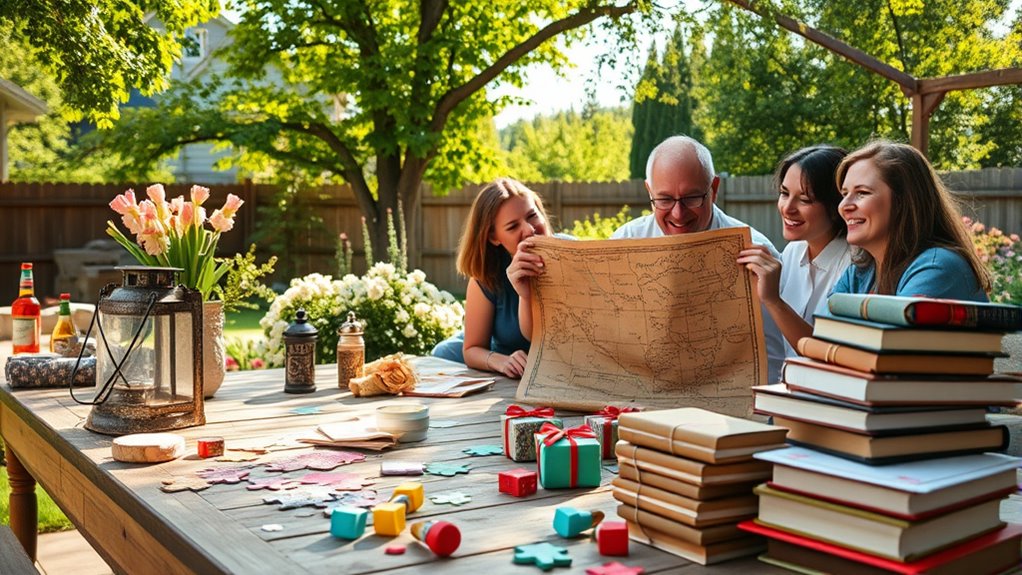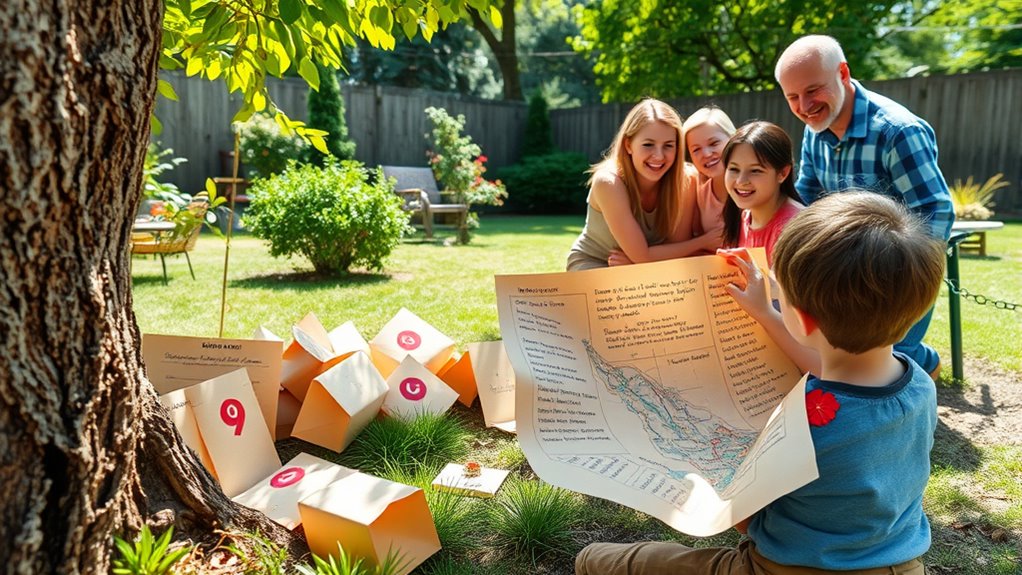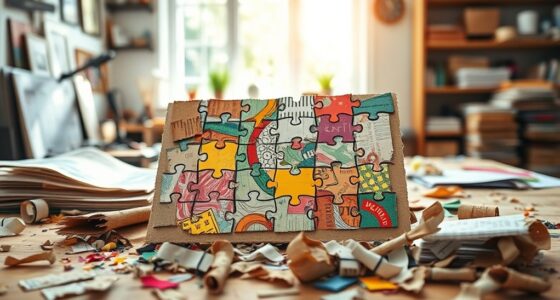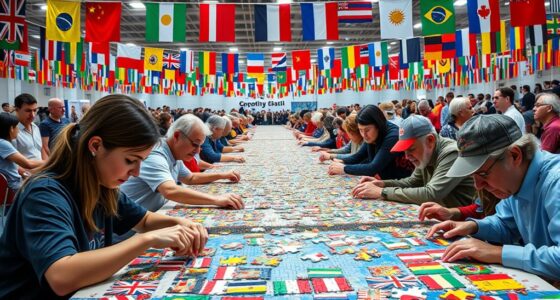To create a puzzle hunt for friends and family, start by choosing an engaging theme or story that everyone will enjoy. Design puzzles that fit the theme, mixing riddles, physical challenges, or scavenger clues to keep it fun and varied. Map out the clues’ order and hide them around your area, ensuring safety and accessibility. Test your setup to fix any confusing parts. Keep the experience lively and inclusive—if you keep exploring these tips, you’ll craft an unforgettable adventure.
Key Takeaways
- Choose a engaging theme or story to unify the puzzles and create an immersive experience.
- Design varied puzzles that are fun, clear, and appropriate for all ages and skill levels.
- Plan the layout by selecting starting points, clue sequence, and safe locations for hiding clues.
- Test the entire hunt beforehand to ensure clues are understandable and flow smoothly.
- Promote teamwork, encourage communication, and celebrate small victories to keep participants motivated and engaged.

Have you ever wanted to turn a regular gathering into an exciting adventure? Creating a puzzle hunt for friends and family is a fantastic way to do just that. It’s an engaging activity that sparks teamwork, encourages problem-solving, and adds a sense of mystery and fun to any get-together. The key to a successful puzzle hunt lies in careful planning, especially when it comes to team collaboration and puzzle design. When everyone works together, they’ll feel more connected and enthusiastic to solve the clues, making the experience even more memorable.
Start by deciding on a theme or story that ties the entire puzzle hunt together. A compelling narrative keeps participants engaged and motivated to solve each challenge. Once you have your theme, you can begin designing puzzles that fit within it. Think about incorporating different types of puzzles—riddles, scavenger hunts, logic puzzles, or physical challenges—to cater to various interests and skill levels. When designing these puzzles, focus on clarity; each clue should be understandable but still require some thought. Avoid overly complex or obscure puzzles that might frustrate players. Remember, the goal is fun and teamwork, not confusion.
Next, plan the layout of your hunt. Decide on the starting point and the sequence of clues. Spread the puzzles across your space or outdoor area, making sure they’re accessible and safe. To promote team collaboration, assign small groups or pairs, encouraging them to communicate and share ideas. This not only enhances their problem-solving skills but also creates a lively, interactive atmosphere. You can even include hints or a way to ask for help if teams get stuck, ensuring everyone stays motivated and engaged without feeling overwhelmed.
As you prepare the clues, think about how they connect to your overall story or theme. Creative puzzle design adds depth and excitement, making the hunt more immersive. Incorporate physical elements like hidden objects or coded messages, and use props or decorations to set the scene. Once everything is set, do a quick run-through to identify any issues or confusing parts. Testing your puzzle hunt helps you refine the flow and ensures each puzzle is solvable within a reasonable time frame. Additionally, exploring remote hackathons for inspiration on collaborative problem-solving can enhance your approach.
Finally, when your friends and family gather, explain the rules clearly, emphasizing teamwork and fun. Encourage participants to share ideas, celebrate small victories, and support each other. A well-crafted puzzle hunt isn’t just about solving puzzles; it’s about building connections, fostering collaboration, and creating lasting memories. With thoughtful team collaboration and clever puzzle design, you’ll turn a simple gathering into an unforgettable adventure everyone will talk about long afterward.
Frequently Asked Questions
What Are the Best Themes for a Family Puzzle Hunt?
The best themes for a family puzzle hunt include fun, engaging ideas like a pirate adventure or a fairy tale quest. You can incorporate themed costumes to make it more immersive and creative snacks to keep everyone energized. Think of pirate hats or princess crowns, and snacks shaped like treasure chests or magic wands. These elements boost excitement and make the experience memorable, encouraging teamwork and imagination throughout your hunt.
How Do I Tailor Puzzles for Different Age Groups?
You tailor puzzles for different age groups by choosing age-appropriate clues that challenge while remaining fun. For younger kids, use simple riddles and visual puzzles, while older participants can handle more complex riddles and logic puzzles. Focus on balancing difficulty levels to keep everyone engaged without frustration. Adjust clues based on individual skills, ensuring the hunt stays exciting and accessible for all ages involved.
What Materials Are Most Effective for Outdoor Hunts?
Think of your outdoor hunt as a modern-day treasure map quest. Use weather-resistant materials like laminated paper or plastic for treasure maps and outdoor clues, ensuring they withstand rain and wind. Consider waterproof containers to hide clues securely. Bright, durable markers and natural elements like stones or sticks can also serve as clues. These materials keep your puzzle hunt engaging and resilient, making sure your friends and family stay immersed in the adventure.
How Long Should a Typical Puzzle Hunt Last?
A typical puzzle hunt lasts about 2 to 3 hours, giving you enough time to enjoy the challenge without fatigue. You should manage your time wisely by adjusting puzzle complexity; simpler puzzles keep everyone engaged, while more complex ones can extend the duration. Balance the overall hunt length with your group’s pace, ensuring everyone stays energized and engaged throughout the event.
How Can I Ensure All Participants Stay Engaged?
You can keep participants engaged by designing interactive clues that encourage exploration and problem-solving. Incorporate teamwork strategies, like dividing tasks or creating themed challenges, to foster collaboration. Keep the puzzles varied to prevent boredom, and provide timely hints or feedback to maintain momentum. By making the hunt dynamic and inclusive, everyone stays motivated and actively involved, ensuring a fun, memorable experience for all.
Conclusion
Now that you know how to craft your own puzzle hunt, go ahead and set it up for your friends and family. Think of it as planting a garden of curiosity and fun, where each clue is a blooming flower waiting to be discovered. With a little creativity and enthusiasm, you’ll create an experience that’s as exciting as a treasure hunt on a sunny day. So plunge in and watch everyone’s faces light up with joy and surprise!









